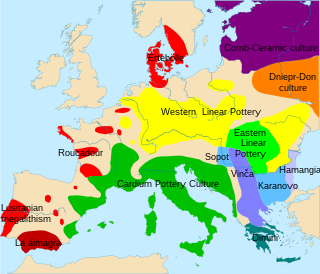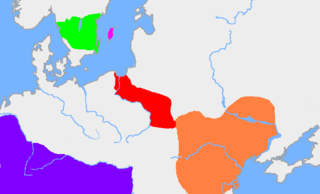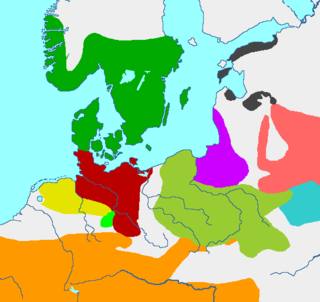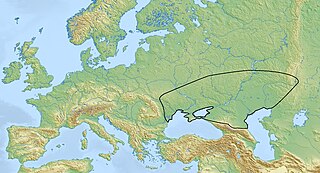 W
WThe Basarabi culture was an archaeological culture in Southeastern Europe, dated between 8th - 7th centuries BC. It was named after Basarabi, a village in Dolj County, south-western Romania, nowadays an administrative component of the Calafat municipality. It is sometimes grouped with related Bosut culture, into the Bosut-Basarabi complex.
 W
WThe Belozerskaya culture is an archaeological culture of the later Bronze Age that replaced the Srubnaya culture on the steppes of Ukraine and Moldova. There are finds near the lower Don and in Kuban and Crimea. It was identified as an independent archaeological culture in the 1980s.
 W
WThe Bijelo Brdo culture or Bjelo-Brdo culture is an early medieval archaeological culture flourishing in the 10th and 11th centuries in Central Europe. It represents a synthesis of the culture introduced in the Carpathian Basin by the conquering Hungarians around 900 and of earlier cultures existing in the territory before the Hungarian conquest. Female dress accessories, including "jewellery of plaited wire, two-piece sheetwork pendants, snake-head bracelets and S-shaped temple-reings", are the most characteristic items of the culture. The culture disappeared around 1100, most probably not independently of laws adopted under Kings Ladislaus I and Coloman of Hungary which prescribed the burial of dead in graveyards developed near churches.
 W
WThe Bondarikhinskaya culture is an archaeological culture during the late Bronze Age that replaced the Srubnaya culture. It was found from the left shore of the Dnepr to the upper and mid Seversky Donets, and it the east it reached the Don bassin and mid-Oka. The culture was identified in the 50s by V. A. Ilyinskaya. It is represented by both fortified and non-fortified settlement, grave fields, treasures and scattered finds. They lived in pit houses, semi-pit houses and houses on flat ground. The cemeteries are tumuli, and flat ground graves with cremated remains in urns or small pits.
 W
WThe Bug–Dniester culture was the archaeological culture that developed in the chernozem region of Moldavia and Ukraine around the Dniester and Southern Bug rivers in the Neolithic.
 W
WBükk culture may have belonged to a dense pocket of Cro-magnon type people inhabiting the Bükk mountains of Hungary and the upper Tisza and its tributaries. The surrounding Neolithic was mainly of a more gracile Mediterranean type, with a Cro-magnon admixture as another possibility. As to whether the Cro-magnons were a remnant squeezed into this pocket, there is no sign of conflict there and the Cro-magnons were doing rather well in the obsidian trade. They were, so to speak, the wealthy men of the European Neolithic.
 W
WThe Carpathian Tumuli culture is the name given to an archaeological culture which evolved in the parts of the Carpathian Mountains between the end of the 2nd and end of the 4th century AD. It was less vast than the area occupied by the Lipiţa culture, encompassing today's Pokuttya, Maramureş, Bucovina and to a lesser extent, Northwest Moldova.
 W
WThe Catacomb culture was a Bronze Age culture which flourished on the Pontic steppe in 2800–1700 BC.
 W
WChernoles culture or Black Forest culture is an Iron Age archaeological unit dating ca. 1025–700 BC. It was located in the forest-steppe between the Dniester and Dnieper Rivers, in the Black Forest of Kirovohrad Oblast in central Ukraine. This location corresponds to where Herodotus later placed his Scythian ploughmen. From 200 BC, the culture was overrun by the arrival of Germanic and Celtic settlers to the region.
 W
WThe Chernyakhov culture, Černjachov, or Sântana de Mureș culture, is an archaeological culture that flourished between the 2nd and 5th centuries AD in a wide area of Eastern Europe, specifically in what is now Ukraine, Romania, Moldova and parts of Belarus. The culture is thought to be the result of a multiethnic cultural mix of the Sarmatian, Slavic, Gothic, and Geto-Dacian populations of the area.
 W
WThe Corded Ware culture comprises a broad archaeological horizon of Europe between ca. 2900 BCE – 2350 BCE, thus from the late Neolithic, through the Copper Age, and ending in the early Bronze Age. Corded Ware culture encompassed a vast area, from the contact zone between the Yamnaya culture and the Corded ware culture in south Central Europe, to the Rhine on the west and the Volga in the east, occupying parts of Northern Europe, Central Europe and Eastern Europe. The Corded Ware culture is thought to have originated from the westward migration of Yamnaya-related people from the steppe-forest zone into the territory of late Neolithic European cultures such as the Globular Amphora and Funnelbeaker cultures, and is considered to be a likely vector for the spread of some or all of the core Indo-European languages, excluding the Anatolian languages and Tocharian.
 W
WThe Coţofeni culture, generally associated with the Usatovo culture, was an Early Bronze Age archaeological culture that existed between 3500 and 2500 BC in the mid-Danube area of south-eastern Central Europe.
 W
WThe Cucuteni–Trypillia culture, also known as the Tripolye culture, is a Neolithic–Eneolithic archaeological culture of Eastern Europe.
 W
WThe Dnieper–Donets culture was a Mesolithic and later Neolithic culture which flourished north of the Black Sea ca. 5000-4200 BC. It has many parallels with the Samara culture, and was succeeded by the Sredny Stog culture.
 W
WThe Epigravettian was one of the last archaeological industries and cultures of the European Upper Paleolithic. It emerged after the Last Glacial Maximum around ~21,000 cal. BP and is considered to be a cultural derivative of the Gravettian culture. Initially named Tardigravettian in 1964 by Georges Laplace in reference to several lithic industries, found in Italy it was later renamed in order to better emphasize its independent character.
 W
WThe Funnel(-neck-)beaker culture, in short TRB or TBK was an archaeological culture in north-central Europe. It developed as a technological merger of local neolithic and mesolithic techno-complexes between the lower Elbe and middle Vistula rivers. These predecessors were the Lengyel-influenced Stroke-ornamented ware culture (STK) groups/Late Lengyel and Baden-Boleráz in the southeast, Rössen groups in the southwest and the Ertebølle-Ellerbek groups in the north. The TrB introduced farming and husbandry as a major source of food to the pottery-using hunter-gatherers north of this line.
 W
WThe Globular Amphora culture, c. 3400–2800 BC, is an archaeological culture in Central Europe. Marija Gimbutas assumed an Indo-European origin, though this is contradicted by newer genetic studies that show a connection to the earlier wave of Neolithic farmers rather than to invaders from the Ukrainian and western-southern Russian steppes.
 W
WThe Ipotești–Cândești culture was an archaeological culture in Eastern Europe. It developed in the mid-6th century by the merger of elements of the Prague-Penkovka and Prague-Korchak cultures and local cultures in the area between Prut and Lower Danube. It stretched in the Lower Danube over territory in Romania and Moldova. The population of the area was made up of Romanized descendants of Daco-Getic (Daco-Romans), Germanic and Slavic tribes. There are views that it derived from the Chernyakhov culture and represented a group of the Antes. The houses were identical to the Slavic huts of the Prague-Korchak and Penkovka areas. The sites in Romania are known as Ipotești-Candești-Ciurel or Ipotești-Ciurel-Cândești.
 W
WKemi Oba culture, ca. 3700—2200 BC, an archaeological culture at the northwest face of the Sea of Azov, the lower Bug and Dnieper Rivers and the Crimea. The Kemi Oba culture is contemporaneous and partly overlapping with the Catacomb culture.
 W
WThe Kyiv culture or Kiev culture is an archaeological culture dating from about the 3rd to 5th centuries, named after Kyiv, the capital of Ukraine. It is widely considered to be the first identifiable Slavic archaeological culture. It was contemporaneous to the Chernyakhov culture.
 W
WThe Linear Pottery culture is a major archaeological horizon of the European Neolithic, flourishing c. 5500–4500 BC. It is abbreviated as LBK, and is also known as the Linear Band Ware, Linear Ware, Linear Ceramics or Incised Ware culture, and falls within the Danubian I culture of V. Gordon Childe.
 W
WLipitsa culture is the archaeological material culture supposedly representative of a Dacian tribe. It took its name from the Ukrainian village of Verkhnya Lypytsya, Ivano-Frankivsk Raion, Ivano-Frankivsk Oblast.
 W
WThe Mikhaylovka culture, Lower Mykhaylivka culture is a Copper Age archaeological culture which flourished on the Pontic steppe from 3600 BC to 3000 BC.
 W
WThe Lusatian culture existed in the later Bronze Age and early Iron Age in most of what is now Poland and parts of the Czechia, Slovakia, eastern Germany and western Ukraine. It covers the Periods Montelius III to V of the Northern European chronological scheme.
 W
WThe Middle Dnieper culture is a formative early expression of the Corded Ware culture, ca. 3200—2300 BC, of northern Ukraine and Belarus.
 W
WThe Milograd culture is an archaeological culture, lasting from about the 7th century BC to the 1st century AD. Geographically, it corresponds to present day southern Belarus and northern Ukraine, in the area of the confluence of the Dnieper and the Pripyat, north of Kyiv. Their ethnic origin is uncertain.
 W
WMulti-cordoned Ware culture or Multiroller ceramics culture, translations of the Russian: Культура многоваликовой керамики Kul'tura mnogovalikovoj keramiki (KMK), also known as the Multiple-relief-band ware culture, the Babyno culture and the Mnogovalikovaya kul'tura (MVK), are archaeological names for a Middle Bronze Age culture of Eastern Europe.
 W
WThe Novodanilovka group, also called the Novodanilovka culture, was a Copper Age culture which flourished along the lower Dnieper and the steppes of Ukraine from c. 4400 BC to 3800 BC.
 W
WThe Penkovka culture is an archaeological culture in Ukraine spanning Moldova and reaching into Romania. Its western boundary is usually taken to at the middle Prut and Dniester rivers, where contact with the Korchak culture occurs. Its bearers are commonly identified as the Antes people of 6th-century Byzantine historiography.
 W
WThe Pomeranian culture, also Pomeranian or Pomerelian Face Urn culture was an Iron Age culture with origins in parts of the area south of the Baltic Sea, from the 7th century BC to the 3rd century BC, which eventually covered most of today's Poland.
 W
WThe Prague-Korchak culture was an archaeological culture attributed to the Early Slavs. The other contemporary main Early Slavic culture was the Prague-Penkovka culture situated further south, with which it makes up the "Prague-type pottery" group. The largest part of sites dates to the late 5th and early 6th century AD according to Late Roman iron fibulae. Settlements were as a rule placed at rivers, near water sources, and were typically unfortified, with 8–20 households with courtyards. Burial sites were both flat graves and barrows (kurgans), and cremation was dominant.
 W
WThe Przeworsk culture was an Iron Age material culture in the region of what is now Poland, that dates from the 3rd century BC to the 5th century AD. It takes its name from the town Przeworsk, near the village where the first artifacts were identified.
 W
WThe Sredny Stog culture is a pre-Kurgan archaeological culture from the 5th millennium BC. It is named after the Russian term for the Dnieper river islet of today's Seredny Stih, Ukraine, where it was first located.
 W
WThe Srubnaya culture, also known as Timber-grave culture, was a Late Bronze Age culture in the eastern part of Pontic–Caspian steppe. It is a successor of the Yamna culture, Catacomb culture and Poltavka culture. It is co-ordinate and probably closely related to the Andronovo culture, its eastern neighbor. Whether the Srubnaya culture originated in the east, west, or was a local development, is disputed among archaeologists.
 W
WThe Suvorovo culture, also called the Suvorovo group, was a Copper Age culture which flourished on the northwest Pontic steppe and the lower Danube from 4500 BC to 4100 BC.
 W
WThe Swiderian culture is an Upper Palaeolithic/Mesolithic cultural complex, centred on the area of modern Poland. The type-site is Świdry Wielkie, in Otwock near the Swider River, a tributary to the Vistula River, in Masovia. The Swiderian is recognized as a distinctive culture that developed on the sand dunes left behind by the retreating glaciers. Rimantienė (1996) considered the relationship between Swiderian and Solutrean "outstanding, though also indirect", in contrast with the Bromme-Ahrensburg complex, for which she introduced the term "Baltic Magdalenian" for generalizing all other North European Late Paleolithic culture groups that have a common origin in Aurignacian.
 W
WThe Tiszapolgár culture or Tiszapolgár-Româneşti culture was an Eneolithic archaeological culture of the Great Hungarian Plain, the Banat, Eastern Slovakia and Ukrainian Zakarpattia Oblast in Central Europe.
 W
WThe Trzciniec culture is a Bronze-Age archaeological culture in East-Central Europe. It is sometimes associated with the Komariv neighbouring culture, as the Trzciniec-Komariv culture.
 W
WThe Urnfield culture was a late Bronze Age culture of Central Europe, often divided into several local cultures within a broader Urnfield tradition. The name comes from the custom of cremating the dead and placing their ashes in urns which were then buried in fields. Over much of Europe, the Urnfield culture followed the Tumulus culture and was succeeded by the Hallstatt culture. Some linguists and archaeologists have associated this culture with the Proto-Celtic language, or a pre-Celtic language family.
 W
WThe Usatovo culture is a late variant of the Cucuteni–Trypillia culture which flourished northwest of the Black Sea from 3500 BC to 3000 BC.
 W
WVolyntsevo culture is the archaeological culture of the early Middle Ages, located between the Dnieper and the Don River rivers. In the west, the territory of the Volyntsevo monuments reaches the right bank of Dnieper in the Kiev area. D. T. Berezovets identified the culture, and named it after the village of Volyntsevo in Sumy Oblast of Central Ukraine, which he excavated in 1948-1950.
 W
WThe Vučedol culture flourished between 3000 and 2200 BCE, centered in Syrmia and eastern Slavonia on the right bank of the Danube river, but possibly spreading throughout the Pannonian plain and western Balkans and southward. It was thus contemporary with the Sumer period in Mesopotamia, the Early Dynastic period in Egypt and the earliest settlements of Troy. Some authors regard it as Bell Beaker during the Kurganization of Europe.
 W
WThe Wielbark culture or East Pomeranian-Mazovian is an Iron Age archaeological complex which flourished on the territory of today's Poland from the 1st century AD to the 5th century AD.
 W
WThe Yamnaya culture also known as the Yamnaya Horizon, Yamna culture, Pit Grave culture or Ochre Grave culture, was a late Copper Age to early Bronze Age archaeological culture of the region between the Southern Bug, Dniester, and Ural rivers, dating to 3300–2600 BC. Its name derives from its characteristic burial tradition: Я́мная is a Russian adjective that means 'related to pits (yama)', and these people used to bury their dead in tumuli (kurgans) containing simple pit chambers. The people of the Yamnaya culture were likely the result of a genetic admixture between the descendants of Eastern European Hunter-Gatherers and people related to hunter-gatherers from the Caucasus, an ancestral component which is often named "Steppe ancestry", with additional admixture of up to 18% from Early European Farmers. Their material culture was very similar to the Afanasevo culture, and the populations of both cultures are genetically indistinguishable. They lived primarily as nomads, with a chiefdom system and wheeled carts and wagons that allowed them to manage large herds.
 W
WThe Zarubintsy or Zarubinets culture was a culture that from the 3rd century BC until the 1st century AD flourished in the area north of the Black Sea along the upper and middle Dnieper and Pripyat Rivers, stretching west towards the Southern Bug river. Zarubintsy sites were particularly dense between the Rivers Desna and Ros as well as along the Pripyat river. It was identified around 1899 by the Czech-Ukrainian archaeologist Vikentiy Khvoyka and is now attested by about 500 sites. The culture was named after finds of cremated remains in the village of Zarubyntsi on the Dnieper.